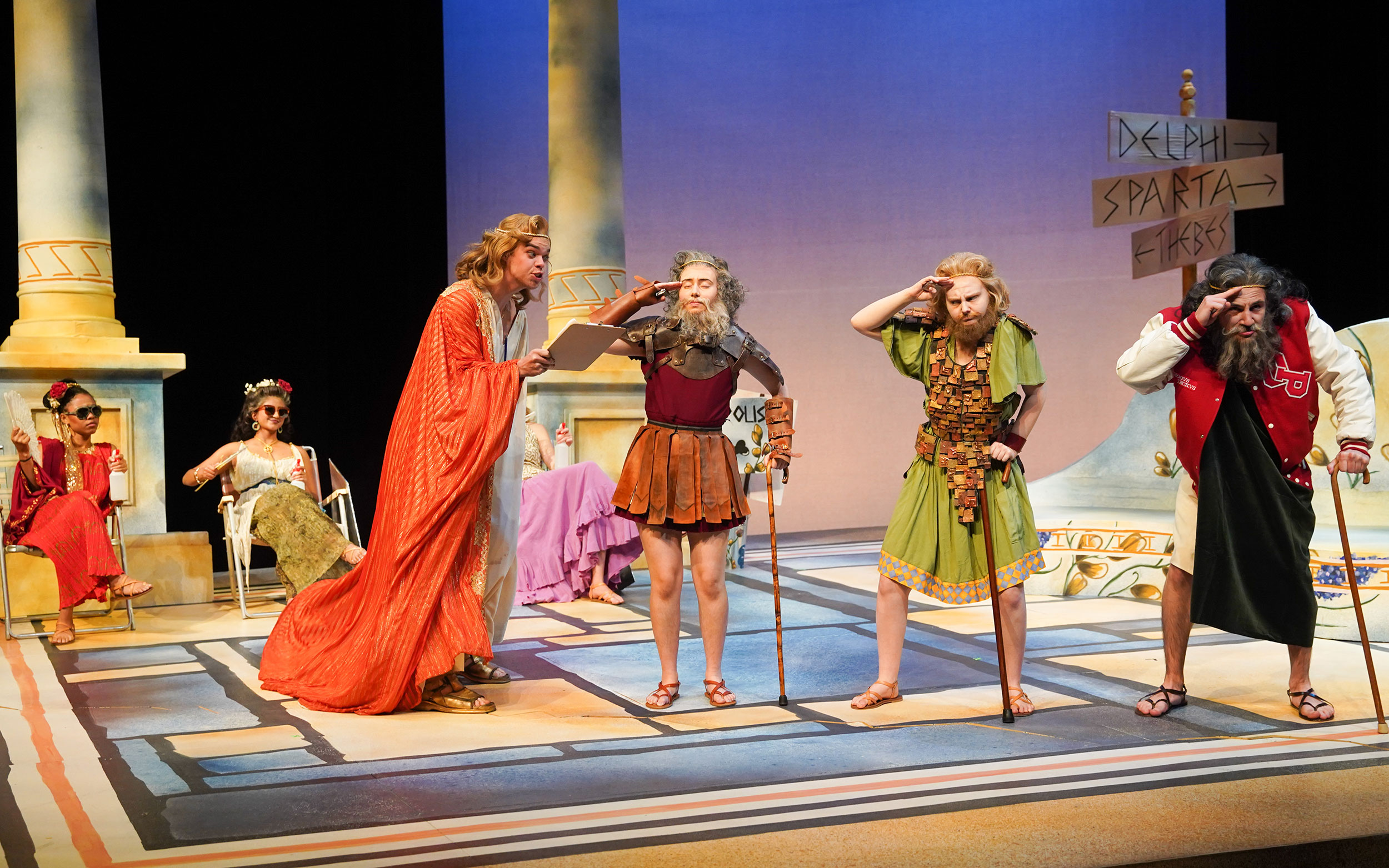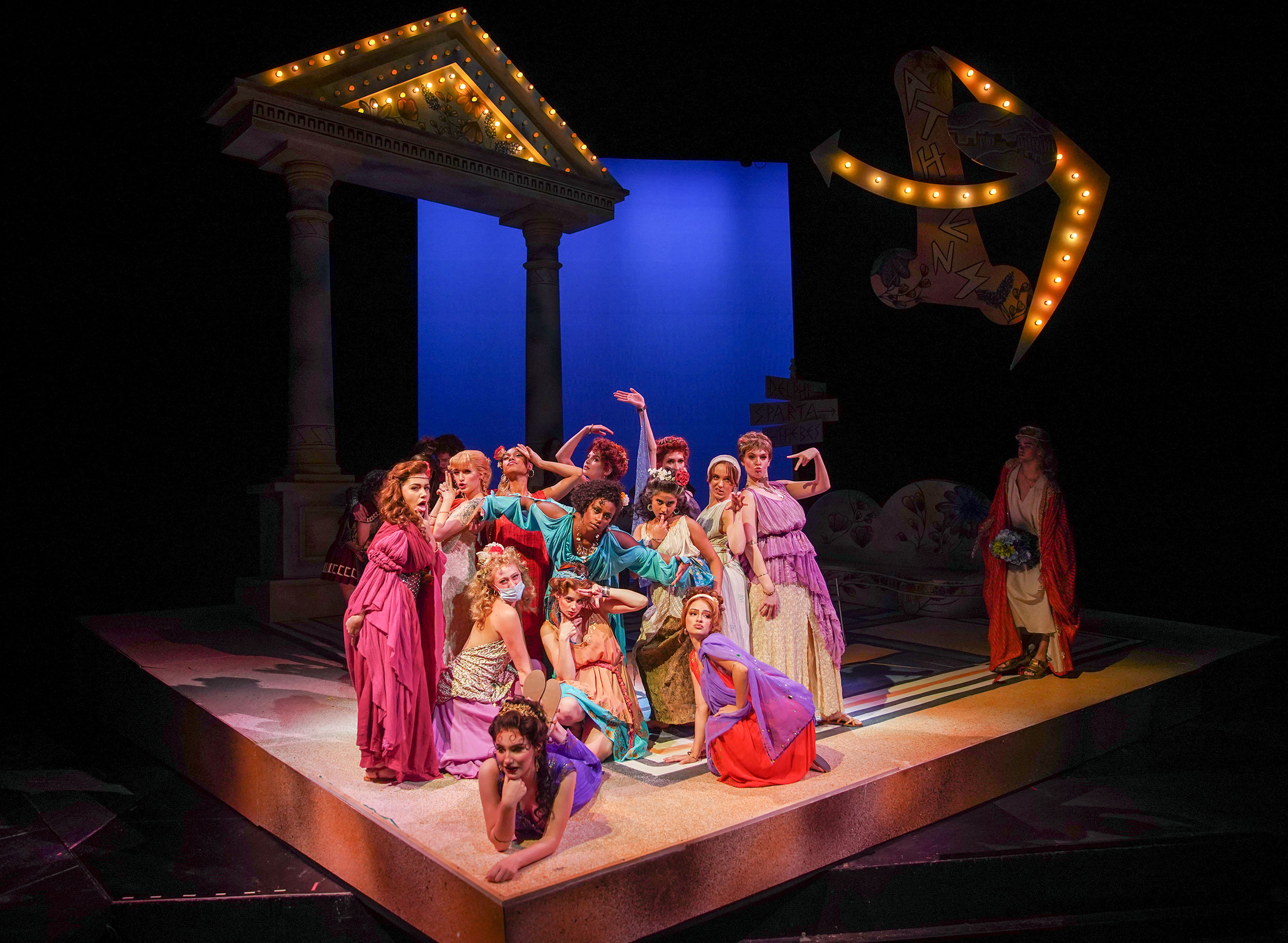By Kathleen Lamorelle, LCT
Lysistrata and The Trojan Women, adapted by Ellen Mclaughlin and directed by Brant Russell is now playing at University of Cincinnati’s College Conservatory of Music. The evening melds a satirical comedic with a contemplative tragedy under an umbrella of common themes: sex and gender, war and peace, motherhood and sisterhood, betrayal and loyalty, suffering and hope, and ultimately, the horrors of war. Based on plays originally penned between 411- 415BCE, both productions grapple with the devastating effects of war on women, albeit through polar opposite approaches.
Despite the somber topic of war, the energetic and committed cast of Lysistrata entertain the audience with continuous sexual innuendos, bawdy language, slapstick, and a clever thread of modern quips sewn atop the ancient. The Chorus Leaders (Staylie Brunner and Lydia Robison) give a witty introduction, and the plot unfolds.
The intelligent Lysistrata (Ava Duvall) is a woman on a mission to end the war in Athens, thereby improving the lives of its women and children. She persuades her friends to withhold sex from men until peace is secured. The ladies begrudgingly take the “No Nookie Oath,” setting up comical situations and opportunities hilarious sex jokes, which the audience clearly appreciates. The conniving women seize Athens’ treasury in the Acropolis, gaining financial power in addition to the emotional power. The men’s ultimate submission to the women’s combined will is farcical, physical comedy, punctuated by wild “appendages” and boisterous double entendres.
The setting (Scenic Designer Sami Tamulonis, Lighting Designer Alaina Pizzoferrato) is defined by a large, Las-Vegas-style phallic landmark sign, inlaid with marquee lights, and situated in front of the imposing marble Acropolis. The women’s beautiful costumes (Costume Designer Erin Donnelly) instantly evoke ancient Greek fashion with richly dyed tunics, intricately adorned hair, and strappy sandals. The men are fashioned in Greek military garb, including shin guards, cloaks, and sandals, or loose fabric which could be refashioned for the task at hand.
At times directly engaging with the audience, the cast successfully pulls off the comedy with confidence, simultaneously driving home the point that Sex is Good; War is Bad. The women only desire “to love and work to the best of their abilities,” not to squander their future for war. Ultimately, the comically inferior, bumbling, silly men yield, and agree to pursue peace for “a piece.”

Intermission gives the audience an opportunity to observe the staging of a show, and offers a physical demarcation between the former comedy and the upcoming tragedy. The bleak situation of The Women of Troy greatly contrasts with the upbeat myrth of Lysistrata, yet it’s a bold punctuation mark to the first play’s message. In both, the women struggle with patriarchal power. However, in the first, the women prevent catastrophe; in the second, the audience witnesses it.
To the sound of moving water (Sound Designer Christopher Berger) Poseidon (Jake Weinheimer) dramatically enters the stage from the ocean, his orb-lit staff leading him in the drab light. His face is made-up to be inhuman, his God-like costume drips with various shades of blue fabric, floating down like water. He laments the downfall of Troy and feels pity for Hecuba, Queen of Troy, yet he exits without claiming responsibility.
Troy, besieged for ten years by a Greek army led by King Agamemnon, has fallen; all of their men are lain. The tragic mood is effectively set by somber, eerie music humming in the background, smoke rising slowly through the crumbling building, and dim, uneven lights shrouding the royal women of Troy. The female captives, disheveled and dirty, are in shock. They await their fate, fearful and uncertain. Will they become slaves? Prostitutes? Be forced to wed and bed their enemies? They lament the loss of their Sisterhood, their friends, their home.
The Greek Chorus, with its precise, modern dance-like movements, successfully heightens the tragic elements of the play, and accentuates the moral themes and messages for the audience (Dramaturg/Director of Choral Movement is Caitlin Hines, Musical Dramaturgy/Vocal Coach is Megan Steigerwald-Ille).
They are mesmerizing to watch and at the same time, their mantras are intensely sorrowful.
Lily Olson shines as Cassandra – dazed and sunken into madness. Rachel Larson plays Hecuba, Queen of Troy, believeably distraught over the loss of her husband and sons, facing life as slave to her enemies. She hates the Greeks and bemoans the loss of her city, family, and way of life. When Hecuba challenges the renowned beauty, Helen (Lydia Robinson) to atone for her actions, sparks fly; Helen is defiant. She defends herself and righteously claims that she, too, is “a piece of property, a toy trophy.” Her nature is contrasted with that of the loyal Andromache, played by Madeleine Gaughan. She loves her warrior husband, Hector, and their baby son. She heartfully cries out that she will find a way to love and hope, in spite of her devastating losses.
If you enjoy both a fun, raucous comedy and a thought-provoking situational tragedy, this is the one to see. It is playing at the University of Cincinnati through Sept. 29-Oct. 2, 2022 at Patricia Corbett Theater. Get your tickets HERE.







